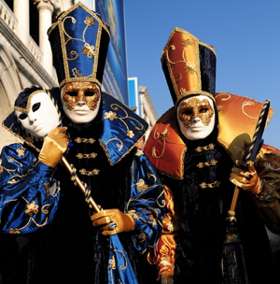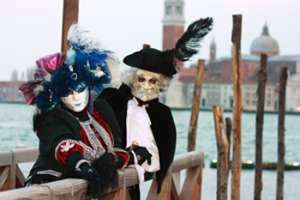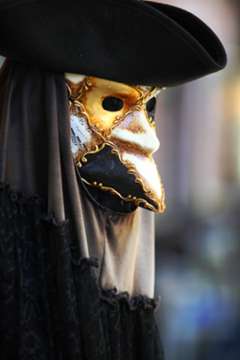The history of the venetian masks
An odd venetian habit lasted for centuries
The history of the venetian masks is quite curious.
I am going now to tell you about it.
As I've already mentioned, citizens in the Republic of Venice, both men and women, were used to disguise themselves in their everyday life.
This shared practice lasted for several centuries, from about the second half of 1200s' until the end of the Veneto Republic in 1797.

The history of the venetian masks stems from the nature of Venice
Basically people wore the masks primarily to hide their social standing than for hiding their own identity, that way allowing citizens of any status, from the average one to the noble man, to be kind of in incognito.
Any servant could be mistaken for an aristocrat, and vice versa. Men and women could be flirting more freely, without the fear of moral judgment and have less inhibitions.
You often could not even tell women from men!
Many boundaries dictated by social status or etiquette were bypassed.
The history of the venetian masks might also be founded on the nature of this maritime town and by the characters of its inhabitants.
Think of this unique town of Veneto: it was a small community, inside a town of narrow roads, both of water and stones.
Did you ever see some stoned venetian streets ( rio, calli) or narrow channels?
As long as you stretch your arm, you can almost touch the opposing house's window. Kind of an oppressive athmosphere sometimes...

On the other side, Venetians were seamen, merchants, adventurers. They ruled over a big part of the eastern Mediterraneo and they were used to the opennes and freedom of the sea.
The Repubblica di Venezia was one of the most important and wealthy powers of the time, with a high standard of living even for the average citizen.
So, it's not that odd, maybe, those people wishing to keep the feeling of freedom once they were at home.
Oscar Wilde...and the mask
You may think that they wanted to hide themselves because they were kind of phoney...
But, actually, this is not it...
It was more like a big fiction, a game, based on the breaking of rules, a luxury that only a wealthy republic, with one of the lowest poverty rate of the time, could afford.
Oscar Wilde once said that Man is least himself when he talks in his own person. Give him a mask and he'll tell you the truth.
This may be the basic meaning of the practice of dressing up in Venice. In Italy and Europe, I don't think we can find such a practice at the time.
So, we may say, the history of the Venetian masks is a way to hide in order to be yourself.

The practice becomes more and more mischievous
Venice was attracting more and more travellers from abroad and with the time its community grew more decadent.
Some people began to take advantage of this venetian habit.
They started to engage in different illegal and immoral acts, such as gambling all day long, and with an excessive sexual promiscuity.
Even priests and nuns would wore masks and acted like the others.
The government of Venice in the second half of 1200 issued the first of a series of laws to limit the misuse of disguise, and to forbid the possession of a weapon while wearing a mask.
From then on, and over the centuries, the town governments voted additional ordinances to control this habit.
For example, they forbad the prostitutes to wear masks, nor could people at gambling disguise themselves any longer.
Moreover, it was banned in certain limited periods of the year, but it was still allowed for the majority of the months in a year though!
The Carnival of Venice
Towards the last decades of the venetian republic, unlike the previous centuries, the disguise was allowed only during the Carnival and parties.
The penalty for not observing those laws were strong sanctions.
The carnival of Venice became more and more important, a real attraction for people from all of Europe.
The carnival masks making became one of the most important business in the Veneto's town. There were requests from other european countries too.
As I have also mentioned that it was forbidden to wear carnival masks outside the carnival and the parties.
But there was an exception: in 1776 a new law required women to go to the theatre with a mask on, such as a bauta, and a long cloak called tabarro.
The history of the venetian masks continues...
The history of the venetian masks and carnival ends in 1797, after more than 500 years of life, with the start of 60 years of austrian domination over the ex Republic of Venice, encompassing the lagoon town, Veneto, Histria and Dalmatia.
During the fascism as well, in Venice and Italy the Carnival was still forbidden.
So, the venetian masks, along with the carnival masks and masquerade ball masks vanished completely.
This continued until the early'80s, when a group of venetian architecture students began to revive this ancient and long tradition.
Since then, the carnival of Venice has turned to be again one of the most important and most beautiful in the world.
The history of the venetian masks, along with the carnival, continues...
From History of the Venetian Masks to Venetian Mask
From History of the Venetian Masks to Veneto Explorer home page